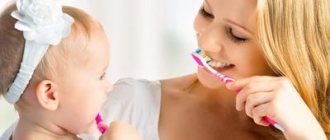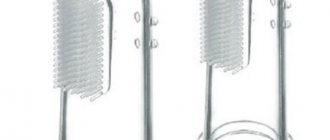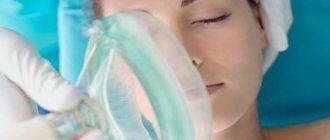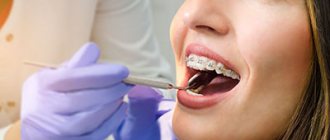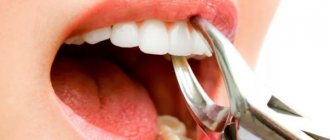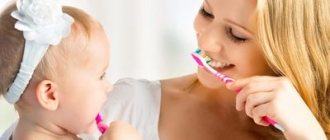Modern methods of treating primary teeth in children aged 2 to 4 years
Modern parents believe that treating a child’s teeth is a waste of time, because over time, milk teeth will be replaced by permanent, healthy teeth without caries.
But every pediatric dentist will call this opinion erroneous, since caries negatively affects not only the oral cavity, but also the condition of other organs and systems of the small patient. The reasons for the development of childhood caries are different. How do young children have their teeth treated today in the Russian Federation? This is done using a gentle method and using only the latest developments in dentistry. Therefore, during this procedure the baby does not experience any discomfort, much less fear.
From 2 to 4 years of age, pediatric dentistry uses the method of silvering baby teeth. A specially developed medicine is applied to the already damaged enamel. The drugs of choice are Saforide and Argenate - they contain 30% silver. After application, the dentin canals close and the spread of bacteria that cause caries stops. This procedure does not bother the baby at all, and he calmly sits for the required time in the chair.
The fluoridation procedure helps eliminate caries in children as reliably as the first method. There are two ways to go here. The first is the application of a fluoride-containing preparation with a brush to the tooth enamel. The second is treatment with a tampon, which is soaked in a special liquid. It contains copper and calcium hydroxide.
Dental treatment today is neither painful nor scary, and this is the main difference between dental offices and those that existed 20 or even 30 years ago. We use modern, effective anesthetics with different flavors, silent drills, and multi-colored fillings, the color of which the child can choose himself.
Diagnosis of caries
Caries in children develops faster and more aggressively than in adults.
This is due to the fact that the enamel of baby teeth is weak and riddled with micropores, where bacteria easily penetrate. Once the carious process begins, the tooth is destroyed in just a few months. This is why it is so important to visit a pediatric dentist every 3-4 months. Symptoms of caries at different stages:
- Initial caries
First, white (chalky) spots appear on the enamel. Then they acquire a yellowish tint, and the surface of the tooth becomes rough. The baby does not feel pain yet, but a reaction to hot and cold food is possible. Initial caries is treated without drilling with a drill. This is the only stage at which it is still possible to restore the enamel and do without a filling. - Medium caries
The enamel layer is destroyed and a carious “hole” is formed. Sharp pain appears when exposed to mechanical or chemical stimuli. Softened dentin and food debris accumulate at the bottom of the cavity. Gentle methods and prevention will no longer help - you need to put a filling. The dental cavity is open and needs to be sealed hermetically with a filling material. - Deep caries
The carious “hole” increases and becomes very noticeable. The enamel and a significant part of the dentin (bone dental tissue) are affected. When probing the bottom of the cavity, a large amount of softened dead tissue is discovered. Deep caries in children is treated with filling. But sometimes the enamel is so destroyed that there is no point in putting a filling; the baby tooth has to be removed.
Visual examination and probing are enough to determine the stage of caries in a child. But sometimes the carious lesion is located in a place that is difficult to access. In this case, an x-ray is prescribed or an intraoral camera is used.
If it is difficult to recognize initial caries, the doctor uses a caries detector. This is a liquid that turns infected tissue blue or pink. Don't worry, the drug is safe for your child's health.
How caries is treated today for young children under 7 years old
According to statistics, caries is one of the most common diseases in children. It proceeds differently for each preschooler, which requires a different approach to each child. Often, only the restorative procedures described above are sufficient. But sometimes a full-fledged complex therapy with fillings and further preventive monitoring of the oral cavity is required.
Treatment of caries in children is carried out with filling material, which is based on glass ionomer cement. One of the representatives of this group is the drug Vitrebond. With its help, treatment is carried out in a short time, and small lesions under this material are restored quickly and painlessly.
How are children's teeth treated in modern dentistry? The most popular method is chemical-mechanical. A medicinal gel is applied to the infected tooth, which allows you to remove damaged dentin painlessly and without the use of drills. In this case, only dead tissue is removed, so the child does not experience any discomfort or pain. Then the tooth, cleaned of carious surfaces, is filled.
The air-kinetic method allows you to clean a carious cavity using a stream of water, air and abrasive particles that enter the mouth under pressure. This jet, directed at the affected area, “washes away” caries. However, this method is effective only at the initial stage of the disease.
But here another question arises - how is pulpitis of baby teeth treated in children? It will not be possible to do this in one visit to the dentist, since the therapy is carried out in several stages. Treatment can be conservative or surgical, but the second method is not used for baby teeth. Therefore, if conservative treatment for pulpitis does not bring results, it is better to remove the affected tooth.
How to treat the teeth of a child 3 years old or older so that he is not afraid and does not cry? Laser technology helps here. Such devices are not installed in all clinics, but in large cities they are available.
And finally, the use of ozone allows you to quickly and painlessly clean the carious cavity and destroy all microbes that cause the destruction of enamel.
What if you don’t treat caries in a child?
Not treating caries on baby teeth means providing your child with a painful childhood. Firstly, caries suddenly “infects” other teeth, and secondly, it almost instantly turns into pulpitis and brings excruciating pain to the baby.
Untreated teeth in children can in the future provoke such serious diseases as:
- chronic allergic processes;
- inflammation in the oral cavity;
- periodontitis;
- chronic inflammation in the mouth.
At what age can teeth be treated?
At what age do children have their teeth treated? This is a question that interests all parents of preschool children.
While the child is breastfed, such a need does not arise, especially since the first teeth begin to appear no earlier than 6 months from birth. But as soon as the child begins to eat at the common table and tries food familiar to the family, parents need to be attentive to the condition of the teeth. Problems with them begin when the body begins to lack minerals. The most dangerous period is from 5 to 14 years.
Therefore, as soon as the baby turns 1 year old, he needs to visit the dentist’s office every 6 months for preventive purposes. Caries or pulpitis of baby teeth detected at an early stage can be treated much easier and faster than advanced cases.
Prevention of bottle caries in children
It is easier to prevent any disease than to treat it later: bottle caries is no exception in this regard.
The disease can be avoided if:
- Brush your teeth immediately after the first tooth erupts. First, a soft toothbrush and a special toothpaste for babies are used for this purpose (there are more than enough of them on store shelves at present); after the child reaches one year of age, you can begin to use dental floss;
- you should not delay giving up bottle feeding - as soon as complementary foods have been introduced, you must immediately teach your child to eat with a spoon;
- You should not leave a bottle with your child’s crib, giving him free access to it;
- there is no need to accustom your baby to sweet drinks - instead of soda and sweet tea, you can give your child plain water and unsweetened tea;
- In no case should you eat with the child with the same spoon - cariogenic bacteria can get from the adult’s body into the baby’s body in this way;
- even if there are no visible changes in the condition of the child’s teeth, you need to visit the dentist for an examination twice a year (since bottle caries develops very quickly, it is better for the doctor to say that the visit was in vain than to announce the need to treat pulpitis).
Where can you get your child’s teeth treated without fear?
It is good if the child is observed by one dentist throughout the entire period from early childhood to 18 years.
Firstly, the baby will always see a familiar doctor in front of him and will not be afraid, cry or worry. And secondly, a specialist who monitors the child’s dental health from an early age knows all its features and will notice the problem at the very beginning of its development. It is important not only how teeth are treated for children 2 years of age and older, but also where it is done. All establishments in the city are divided into three large groups:
- State clinics. This option is best left for last resort. Why? There are long queues, many capricious children, nervous parents and doctors who are given a limited time for an appointment and not a minute more. At the same time, dental equipment, as a rule, remains from the last century, and no one has heard of good medicines and fillings.
- Special children's rooms in high-profile private hospitals. If you are looking for a good combination of price and quality, then this option is suitable. There is all the necessary equipment, modern medications designed specifically for baby teeth, and a specialist doctor whose competence includes only the treatment of children’s first teeth will work with a boy or girl.
- Private specialized children's dental clinics. They are intended exclusively for small patients. Here everything is done for their coziness and comfort, there are no long queues, all patients come only at the appointed time, and you can make an appointment for a convenient day for an appointment. All equipment, instruments and medications are intended exclusively for children's teeth. Well, the quality of service always remains at the highest level. The only negative is the high prices, and even a simple consultation will be paid.
Which treatment methods to choose and where exactly the baby should be treated is, of course, decided by the parents. You should not go to extremes and should choose according to your financial capabilities. After all, even in a free city clinic you can get access to competent and experienced specialists. The only thing that remains is to read the reviews and ask your friends who and how they treat the teeth of children aged 4 years. If possible, immediately contact a paid pediatric dentistry.
Prevention of caries
Many pediatric dentists offer painless and fun treatment. But it is easier to prevent than to treat. Simple preventive measures will help preserve the integrity of baby teeth for as long as possible:
- Daily oral hygiene. As soon as the first tooth appears, you need to purchase children's toothpaste and a brush. Grooming should be done twice a day - morning and evening, and gradually become a healthy habit for the child.
- Proper nutrition. It is necessary to include foods high in calcium (kefir, cottage cheese, cheese, etc.), as well as vegetables and fruits, in the child’s diet. Harmful sweets and fast carbohydrates, on the contrary, should be excluded or reduced as much as possible in the daily menu.
- Preventative examinations with a doctor. A pediatric dentist should be visited 2-4 times a year. This will allow you to monitor dental health and reduce the risk of caries in your child.
It is recommended that a child’s first meeting with a dentist take place after the incisors appear – at 1-1.5 years. This will be a preventive examination, during which parents will be told the principles of caring for children’s teeth and advised on the optimal scheme for monitoring the growth of temporary units.
Watch an informational video on this topic
Treatment of permanent teeth in children
Permanent teeth, like baby teeth, also require careful care and sometimes treatment. At the initial stage, caries therapy can be carried out using methods such as:
- Silvering, which has an antibacterial effect and helps stop the process of further destruction of the enamel.
- Remineralization is carried out for children who attend primary school.
- Ozone therapy is a painless method that does not injure the oral cavity.
For superficial caries, a popular method is fluoridation or filling. Medium and deep caries require a more serious approach to treatment - here safe fillings containing silicophosphate cements are installed. To clean the dental canals, depophoresis with a calcium solution is used. Finally, laser therapy is well suited for the treatment of permanent teeth. It helps to forget about the drill and scalpel, but this method is used in children over 7 years old.
Types of caries
- White spots appearing on the enamel. This is the very initial stage of caries, which is indicated by the appearance of white spots - foci of demineralization. At this stage, the dental tissue has not yet begun to deteriorate, and only chalky stains indicate that not everything is normal. However, if you ignore the appearance of these spots and do not contact your dentist, the enamel will continue to suffer from a lack of calcium and, as a result, deteriorate.
- Painless superficial caries - damage that affects the enamel and does not harm the underlying dentin. If such caries is not treated, it will move to the next stage.
- Medium caries is damage to the enamel and dentin underneath. If you allow cariogenic organisms to get close to the dentin, tooth destruction will occur much faster, since the bone substance of the tooth is softer in structure than the enamel.
- Deep caries, when a thin layer of dentin remains. If the dentin becomes completely thin, then caries will affect the pulp of the tooth, which will cause a lot of pain to the child.
Bottle caries is one of the types of dental damage. The term comes from a bottle of drink (usually sweet) that is often within a child's reach at night. These carious formations affect the upper incisors.
If caries is ignored and no measures are taken to eliminate it, complications may arise. Average caries, left unattended, will lead to the penetration of microorganisms into the pulp, which will cause pulpitis (characterized by severe pain that does not even allow you to sleep) and periodontitis (it is distinguished by the formation of a lump or fistula on the gum, filled with pus).
Anesthesia for dental treatment
Treating a child’s tooth while sleeping is much more convenient and safer. Therefore, often in children, dental treatment under anesthesia is preferable to without it. At the same time, dentists are confident that the use of gas as anesthesia does not cause any harm to the body, even of an infant.
Treating teeth under anesthesia for a child aged 2 to 4 years is one of the most convenient and popular methods. The inhalation method is based on the fact that the baby simply inhales a special mixture, and then calmly falls asleep. Doctors provide treatment, and then the child wakes up with no memory or pain or fear of doctors.
To use inhalation anesthesia, the clinic must have a license, the necessary equipment, and an experienced anesthesiologist who knows how to work with children. It is important to remember that under general anesthesia, teeth are treated only for a healthy child - he should not have a cold, and at least two weeks must have passed since the acute respiratory infection, acute respiratory viral infection or other illness. Also, do not use this method immediately after vaccination.
Local anesthesia is another popular method of pain relief. But if it is customary to treat teeth in a dream in young children, then this method can be used in schoolchildren. Its essence is that an anesthetic drug is injected into the gum using a syringe and a needle, which will not allow the child to feel pain during treatment.
All modern technologies that exist in Russia only work to quickly cure teeth at the moment when they manage to persuade the child to open his mouth. But can the quality of such treatment be at its best? It will not be possible to completely remove infected and diseased tissue. Not to mention fillings, whose task is to harden faster in order to somehow cover carious holes. This leads to the fact that soon the parents bring the child to the doctor again, but now with even greater problems.
An equally popular problem is the baby’s fear. Therefore, inhalation anesthesia is an easy way to cure a child’s carious teeth in one visit to the doctor, and then not remember about this procedure until the next preventive examination.
Technology and materials
Dental treatment using the icon system has a number of features. These include the following:
- The procedure will be effective only when treating caries at the spot stage, that is, when there is no superficial damage to the enamel.
- Anesthesia is not required, since a drill or other mechanical methods of treating the tooth are not used.
- Without a drill.
- Strengthening the structure of teeth and protecting it from negative environmental factors.
- Infiltration – does not lead to the appearance of microcracks. This ensures minimal risks for re-injury.
- Preservation of the natural shade and naturalness of the dental unit in comparison with the rest of the dentition.
Using the icon method allows you to treat caries without preliminary preparation. A number of drugs and materials are used to carry out the procedure:
- A special gel containing hydrochloric acid.
- Ethanol.
- Composite materials that harden under light rays.
Several options for infiltration kits are available. The first is for treating areas in close proximity to the mucous membrane. The second, for use in areas located in close proximity to adjacent healthy teeth.
Treatment of caries without preparation using the icon system allows you to get beautiful, smooth, transparent and healthy enamel. The action of the compositions begins immediately after application. Without affecting the tooth tissue, the solution penetrates directly into the damaged cavity. A qualified specialist is the key to the success and effectiveness of the procedure. The cost of icon caries treatment will depend on the patient’s clinical picture. However, the cost will be in the range of 4000-6000 rubles.
Psychological aspect
To prevent children from being afraid of dentists, clinics use distracting maneuvers. While waiting and even during treatment, children can be shown their favorite cartoons. You can read a fairy tale, play games. Some clinics even have special rooms where boys and girls can relax and forget about the fear of an unfamiliar doctor.
The staff in children's clinics dress in bright clothes, and you can see smile masks on their faces. Each office has a thoughtful interior that resembles not a hospital, but a gaming center. The best clinics employ a psychologist who helps the child overcome his fear of dental treatment. The rest of the staff also takes courses in communicating with children.
A child’s teeth can be treated without general anesthesia, but it is better to use this safe method today. The main thing is to make it clear to the child from a very early age that the dentist is not a terrible doctor, but a friend of teeth from childhood.
Author: Zhukov M.A.
Stages of treatment
Like any other dental service, treatment using the icon system (Moscow) has its own characteristics.
Duration
The duration of the procedure is only about 25 minutes. The patient will only need to visit the dentist once for treatment. In addition, absolute painlessness does not require additional measures before the procedure: sanitation of the oral cavity, administration of anesthesia and others.
Procedure
Treatment of caries without drilling icon begins with cleaning the tooth surface from bacterial plaque. Using a special latex plate (rubber dam), the dentist isolates the dental units from the oral mucosa. This is done to ensure the surgical field is dry. After this, special wedges are used to move the teeth slightly away from each other. The sensations are not entirely pleasant, however, in comparison with a drill, they are quite tolerable.
The next step is to etch the affected area with a special solution. This is done in order to open the pores in the carious area. The composition is formed by amino acids and sodium hypochloride (HCl). The duration is only two minutes, after which the gel is washed off with water, and the dental units are dried with air currents.
After completing the preparatory stage, the dentist proceeds to the actual treatment of the tooth. The doctor alternately applies two polymers to the affected area. The first one is applied for 3 minutes and then exposed to exposure. 2nd – for 1 minute, during which the carious cavity is sealed. The effect will be noticeable immediately. The cured tooth acquires a uniform white shade and a healthy appearance.
Advantages of this method:
- The development of caries can be stopped in the early stages and for a long time, thereby increasing the life of the tooth.
- No pain, no preparation (drilling) or anesthesia required.
- With this treatment, healthy tooth tissue is preserved, and the treated surface looks like healthy enamel.
- The opportunity to better preserve teeth when there is a particular predisposition to the development of caries (childhood and adolescence, pregnancy, specific diseases, as well as superficial caries caused by poor hygiene, when treated with braces)
- Highly aesthetic treatment (front surfaces of anterior teeth)
- Complete treatment is performed in one visit.
Why is caries of baby teeth dangerous?
Untreated dental disease in baby teeth is a source of infection that develops in a child’s mouth. It can cause various complications and pathological conditions:
- Increases the risk of developing malocclusion.
- It negatively affects the rudiments of permanent teeth and can cause their damage.
- It affects other organ systems and can lead to the development of ENT diseases and gastrointestinal diseases.
- Reduces the child's immunity.
It is necessary to treat baby teeth. This is about caring for the child's health.




